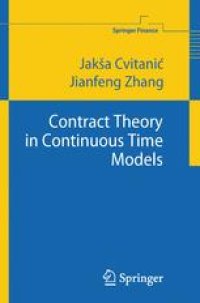
Ebook: Contract Theory in Continuous-Time Models
- Tags: Quantitative Finance, Game Theory Economics Social and Behav. Sciences, Systems Theory Control
- Series: Springer Finance
- Year: 2013
- Publisher: Springer-Verlag Berlin Heidelberg
- Edition: 1
- Language: English
- pdf
In recent years there has been a significant increase of interest in continuous-time Principal-Agent models, or contract theory, and their applications. Continuous-time models provide a powerful and elegant framework for solving stochastic optimization problems of finding the optimal contracts between two parties, under various assumptions on the information they have access to, and the effect they have on the underlying "profit/loss" values. This monograph surveys recent results of the theory in a systematic way, using the approach of the so-called Stochastic Maximum Principle, in models driven by Brownian Motion.
Optimal contracts are characterized via a system of Forward-Backward Stochastic Differential Equations. In a number of interesting special cases these can be solved explicitly, enabling derivation of many qualitative economic conclusions.
In recent years there has been a significant increase of interest in continuous-time Principal-Agent models, or contract theory, and their applications. Continuous-time models provide a powerful and elegant framework for solving stochastic optimization problems of finding the optimal contracts between two parties, under various assumptions on the information they have access to, and the effect they have on the underlying "profit/loss" values. This monograph surveys recent results of the theory in a systematic way, using the approach of the so-called Stochastic Maximum Principle, in models driven by Brownian Motion.
Optimal contracts are characterized via a system of Forward-Backward Stochastic Differential Equations. In a number of interesting special cases these can be solved explicitly, enabling derivation of many qualitative economic conclusions.
In recent years there has been a significant increase of interest in continuous-time Principal-Agent models, or contract theory, and their applications. Continuous-time models provide a powerful and elegant framework for solving stochastic optimization problems of finding the optimal contracts between two parties, under various assumptions on the information they have access to, and the effect they have on the underlying "profit/loss" values. This monograph surveys recent results of the theory in a systematic way, using the approach of the so-called Stochastic Maximum Principle, in models driven by Brownian Motion.
Optimal contracts are characterized via a system of Forward-Backward Stochastic Differential Equations. In a number of interesting special cases these can be solved explicitly, enabling derivation of many qualitative economic conclusions.
Content:
Front Matter....Pages I-XII
Front Matter....Pages 1-1
Principal–Agent Problem....Pages 3-6
Single-Period Examples....Pages 7-14
Front Matter....Pages 15-15
Linear Models with Project Selection, and Preview of Results....Pages 17-24
The General Risk Sharing Problem....Pages 25-43
Front Matter....Pages 45-45
Mathematical Theory for General Moral Hazard Problems....Pages 47-84
Special Cases and Applications....Pages 85-113
An Application to Capital Structure Problems: Optimal Financing of a Company....Pages 115-134
Front Matter....Pages 135-135
Adverse Selection....Pages 137-153
Front Matter....Pages 155-155
Backward SDEs....Pages 157-182
Stochastic Maximum Principle....Pages 183-227
Forward-Backward SDEs....Pages 229-248
Back Matter....Pages 249-255
In recent years there has been a significant increase of interest in continuous-time Principal-Agent models, or contract theory, and their applications. Continuous-time models provide a powerful and elegant framework for solving stochastic optimization problems of finding the optimal contracts between two parties, under various assumptions on the information they have access to, and the effect they have on the underlying "profit/loss" values. This monograph surveys recent results of the theory in a systematic way, using the approach of the so-called Stochastic Maximum Principle, in models driven by Brownian Motion.
Optimal contracts are characterized via a system of Forward-Backward Stochastic Differential Equations. In a number of interesting special cases these can be solved explicitly, enabling derivation of many qualitative economic conclusions.
Content:
Front Matter....Pages I-XII
Front Matter....Pages 1-1
Principal–Agent Problem....Pages 3-6
Single-Period Examples....Pages 7-14
Front Matter....Pages 15-15
Linear Models with Project Selection, and Preview of Results....Pages 17-24
The General Risk Sharing Problem....Pages 25-43
Front Matter....Pages 45-45
Mathematical Theory for General Moral Hazard Problems....Pages 47-84
Special Cases and Applications....Pages 85-113
An Application to Capital Structure Problems: Optimal Financing of a Company....Pages 115-134
Front Matter....Pages 135-135
Adverse Selection....Pages 137-153
Front Matter....Pages 155-155
Backward SDEs....Pages 157-182
Stochastic Maximum Principle....Pages 183-227
Forward-Backward SDEs....Pages 229-248
Back Matter....Pages 249-255
....